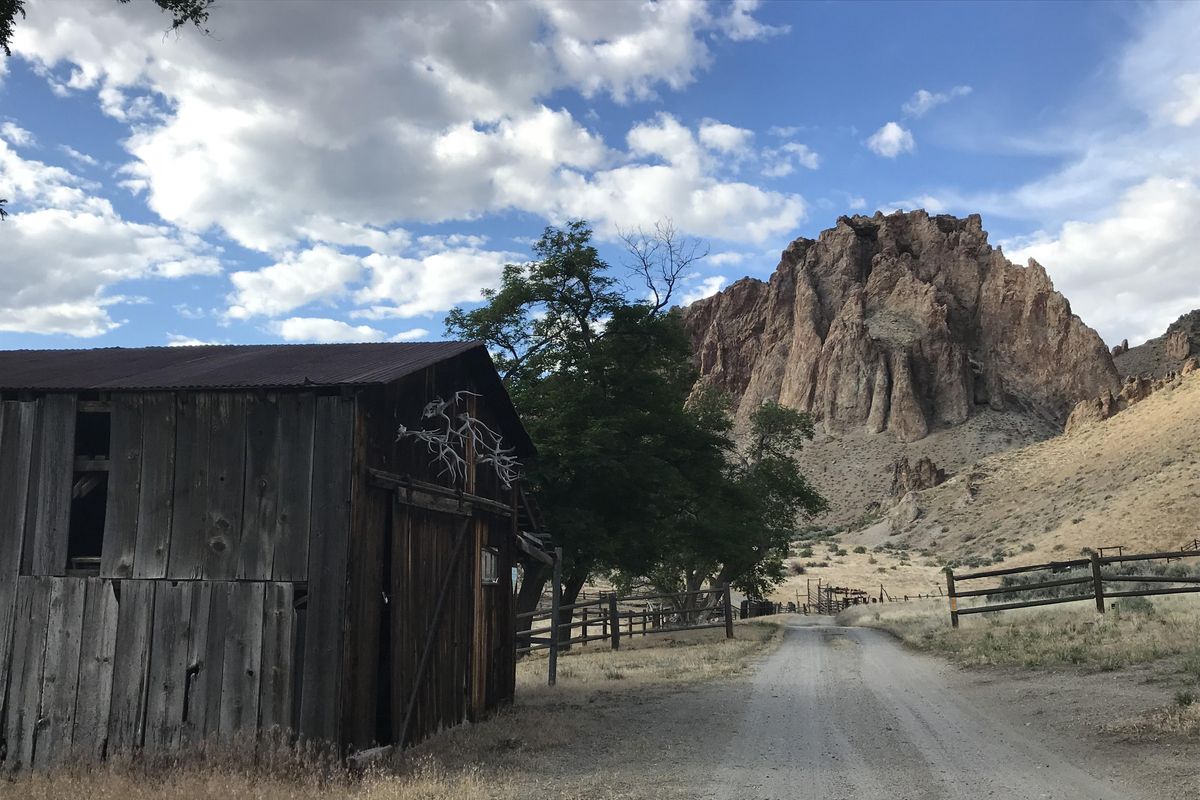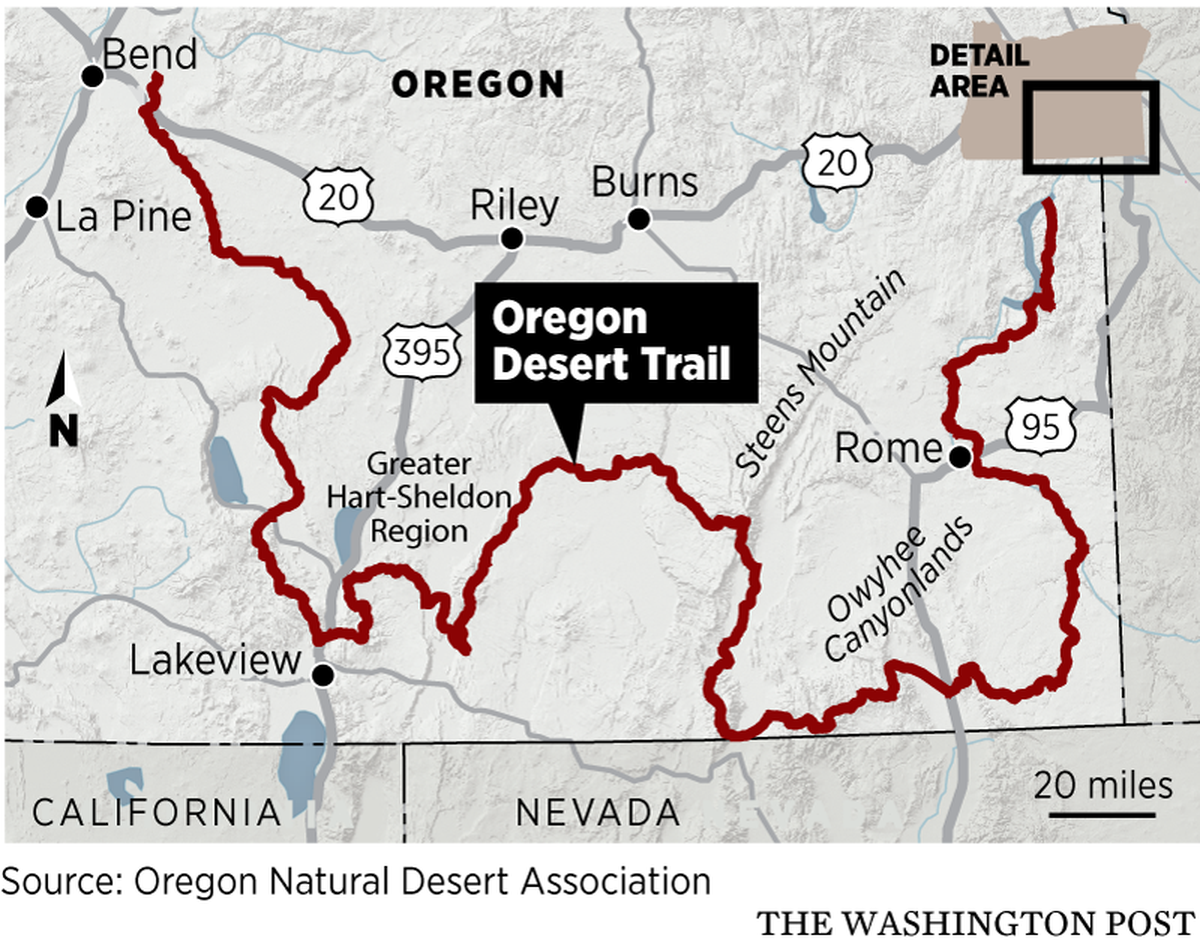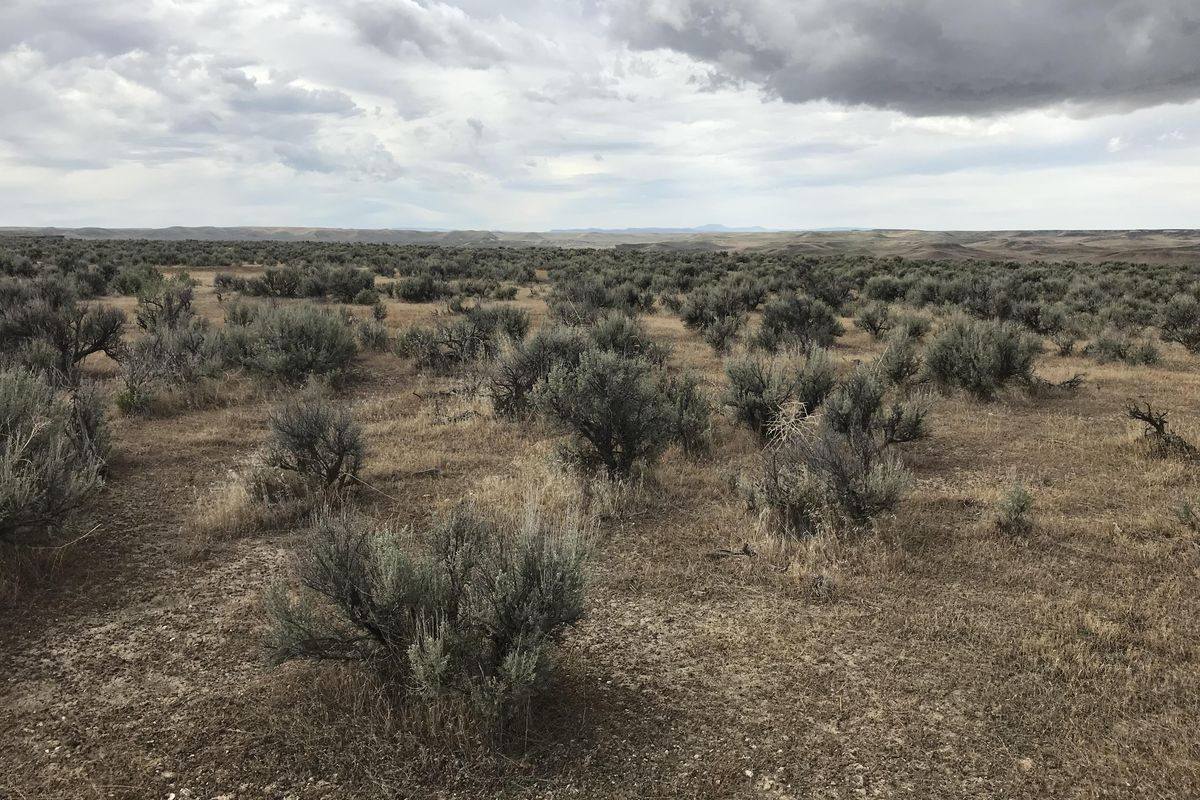The Oregon Desert Trail is just that, complete with canyons and rattlesnakes
Sagebrush stretches across miles of flatland outside of Rome, Ore., making it difficult to navigate the unmarked Oregon Desert Trail. Hikers are encouraged to take a map, compass and GPS device. (Emily Gillespie / Emily Gillespie/For The Washington Post)
I felt every drop of sweat make its way down my face, neck and back as I stared down the rattlesnake, its beady eyes locked with mine, daring me to move. At this point, a few miles into my solo-backpacking trip through Oregon’s remote desert, I considered turning around and heading the several miles back to my car. After I caught my breath, I shook off the idea. Testing myself, I thought, is exactly what I signed up for.
I’d had the idea for the trip a few months ago. Travel Oregon had released an elaborate animated advertisement featuring lush rivers, snow-peaked mountains, miles of vineyards and coastline, and breathtaking Crater Lake. When I watched it, I couldn’t help thinking: false advertising.
Though Oregon is often depicted in terms of Douglas fir-filled forests, the truth is that half the state is a water-starved desert. Even I, after calling Oregon home for 20 years, am guilty of green-washing: Although I knew the desert was within Oregon’s borders, I had never explored it. Then I learned of the Oregon Desert Trail, a 750-mile, W-shaped path that weaves through the state’s most arid landscape. The trail shows off some of the state’s unsung attractions, including the Oregon Badlands, Lost Forest, Owyhee Canyonlands and picturesque Steens Mountain, a single mountain that stretches more than 9,000 feet high and 50 miles north to south.
Created by the Oregon Natural Desert Association (ONDA) conservation group as a way to spur appreciation for the lands it is trying to protect, the trail is unusual in many ways. A big one: It isn’t really a trail. Waypoints on a map will help guide you, but the route isn’t marked. One-third of the route is cross-country, so a GPS device and compass skills are necessary; finding your own way gives the journey a choose-your-own adventure quality.
Carving through the least-populated areas of the state, the trail is also remote – but that’s part of its appeal. Wildlife biologist and thru-hiker Sage Clegg, the first person to hike the trail end-to-end, said she really only saw other people when she went into a nearby town to resupply.
The trail’s stewards also see its location as part of its charm. “You might hear people say, ‘There’s nothing out there, it’s a wasteland,’ ” trail coordinator Renee Patrick said. “We don’t think its wasteland. It’s one of the most remote places left in our country, and we want people to experience that firsthand.”
Because I’m not a thru-hiker, I settled on a 22-mile loop that traversed one of the canyons that makes up the Owyhee Canyonlands, an area affectionately called “Oregon’s Grand Canyon.” Tucked in the southeast corner of the state, the undeveloped area is also one of the largest unprotected areas in the American West. I planned three days for the loop. In preparation for the desert conditions, I went on an exposed six-mile hike near Portland on an unusually hot day and barely went through a liter of water. To be safe, though, I planned to drink about three liters of water a day and would carry more than twice that amount for one stretch of the hike.
I spent the night before my hike at Birch Creek Historic Ranch. Homesteaded around 1900, the property along the Owyhee River is now a popular spot for rafters. I was disappointed that it was cloudy when darkness fell, because the region is one of the largest pockets of land untouched by light pollution, according to a 2016 analysis of artificial light called the New World Atlas of Artificial Sky Brightness. In the middle of the night, however, loud bullfrogs alerted me to the cloudless sky overhead. The dark, empty backdrop allowed the stars the perfect stage to dazzle and the moon shone down on me like a headlight.
The next day, I left the ranch on foot and followed an old jeep road to an open field before reconnecting with the river. The scenery was so breathtaking that more than once I stopped abruptly and said “wow,” even though no one was around to hear it.
After only a few hours of hiking, though, I felt the desert’s ruthless effects. It was, in a word, grueling. The first six miles, which on a path would normally take me about three hours, took eight. At times, the steep canyon walls emptied straight into the river and my options for moving forward were to hop along boulder-sized lava rocks, machete my way through thick reeds of grass taller than myself or scramble up the hillside and walk at a slant.
With the glaring sun beating down on me, rattlesnakes restarting my heart and extra time and energy spent calculating my next step, I was exhausted by the end of the day. I was also out of water. In practice, instead of three liters a day, I’d gone through three liters in half a day.
After setting up my tent along a rare bit of flat, sandy ground, I decided to turn my three-day trip into an overnight out-and-back. I was learning firsthand an important lesson of the desert: Water is king.
Sitting at camp and feeling a bit clobbered by the hostile landscape – I would encounter three more rattlesnakes on my way back – I looked up to catch the sun setting on a circular rock towering on a hill across the river. In the golden hue, it reminded me of the Colosseum. Rock formations like this one, and another in the region reminiscent of ancient pillars, make it easy to see why a nearby town is named Rome. After hiking out the next day, I drove in that direction, stopping for a night at a bed-and-breakfast.
On what would have been the third day of the original loop plan, I set out to find an area that would give me a taste of the cross-country hiking I had missed by cutting that trek short. I settled on a stretch of the Oregon Desert Trail near Rome – which turned out to be a dot on the map that I would have blown by if not for a lone business along Highway 95.
After scaling a hill, I was met with flatland. The only thing in sight was miles and miles of sagebrush. The level ground made it a much easier hike, but after about an hour into my journey, I picked up on what made this part of the trail difficult: keeping track of where you are going. More than once I glanced down at my GPS to learn I was headed in the opposite direction of where I wanted to go.
After my hike, I stayed the night at Rome Station, a part-convenience store, part-diner with a few cabins. Over a burger and beer at the bar, I chatted with owner Joseph McElhannon and a fellow patron, a self-proclaimed cowboy-poet from Texas who wore his long, gray hair tucked under a wide-brim straw hat and a leather vest over his long-sleeved black T-shirt.
McElhannon told me that he likes the trail, but doesn’t like ONDA. Over the years, the conservation group has made land-use proposals that have left ranchers worried about grazing rights and business-owners like McElhannon concerned about access for hunting, a sport that keeps his business going in the winter.
Despite his reservations, McElhannon agreed to have Rome Station listed among the trail resources and was holding a few resupply packages for hikers due to stop by in the coming months. He said he likes hikers; he used to be a backpacker. Even more, he loves showing people the beautiful slice of world he calls home.
The experience left me with a new appreciation for this part of the state and for hiking without the ease and comfort of a trail. Doing just a small portion of the Oregon Desert Trail reminded me of nature’s riotous side and challenged me in the best way.


